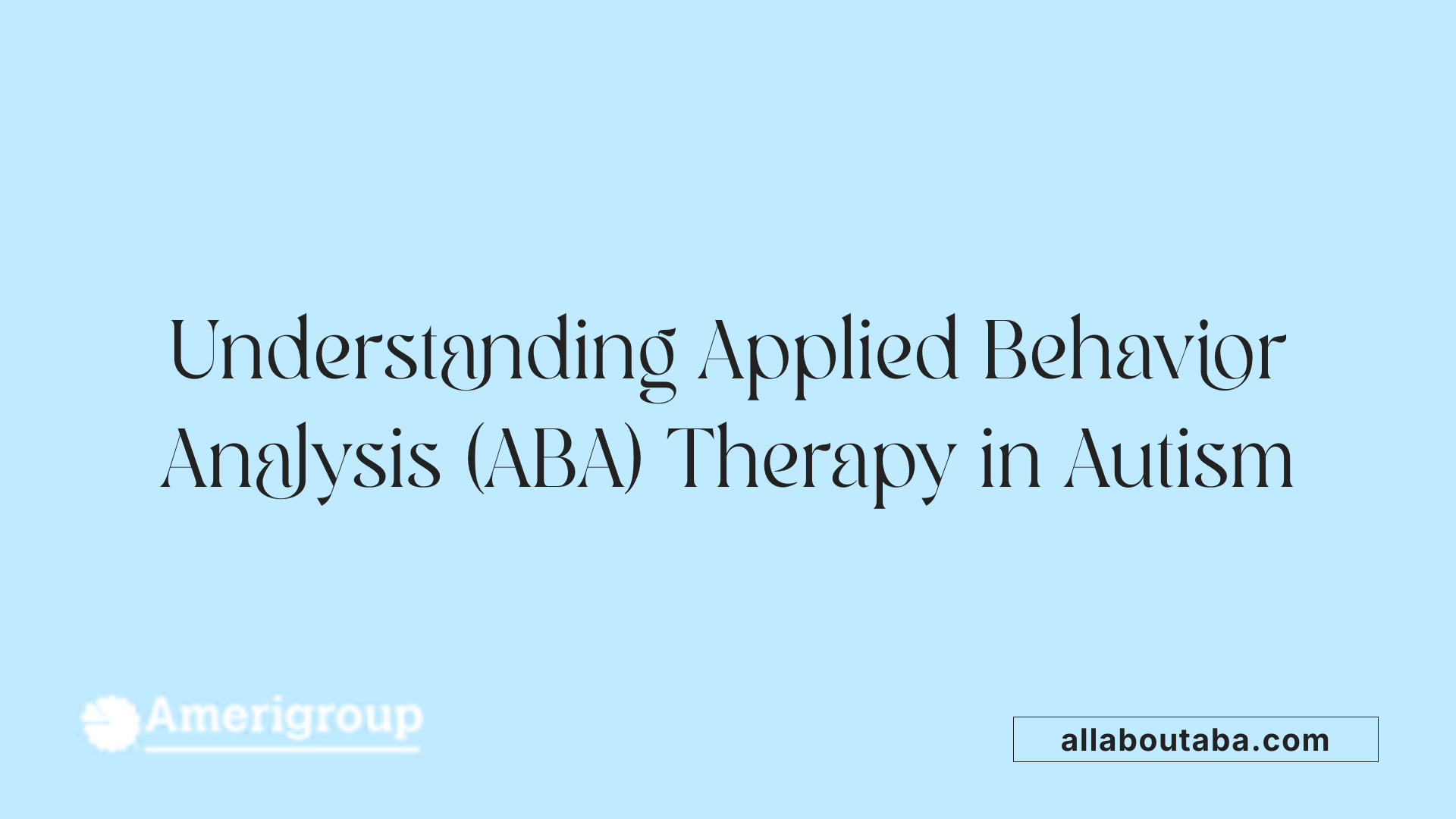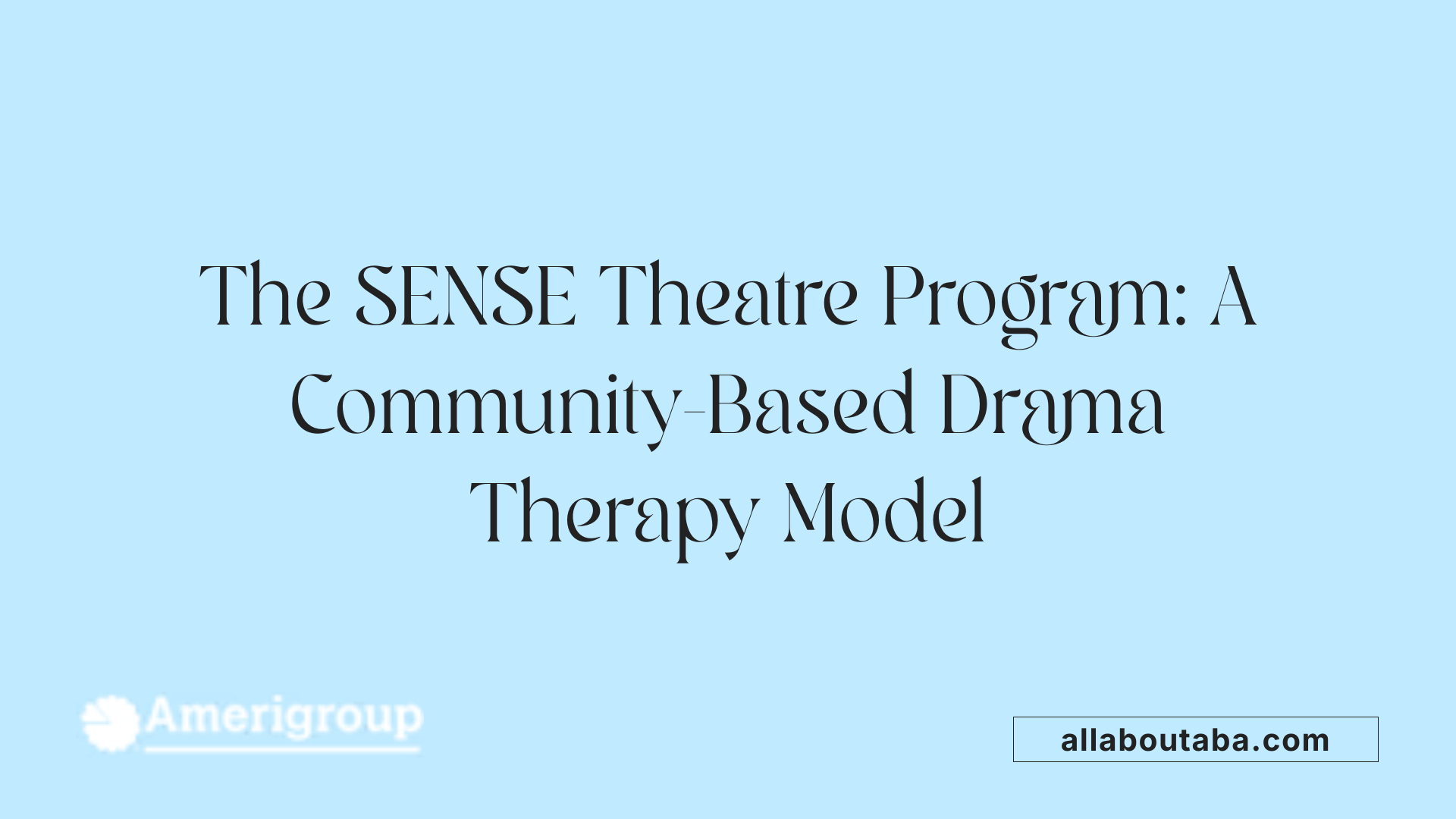How Drama Therapy Benefits Autistic Individuals
Bridging Social Gaps through Dramatic Expression
Drama therapy has gained increasing attention as a creative and effective intervention for children with Autism Spectrum Disorder (ASD), especially those with high-functioning autism. This article explores how structured theatrical and drama-based interventions foster improvements in social communication, emotional recognition, and behavioral regulation among autistic children, contrasting and complementing traditional approaches like Applied Behavior Analysis (ABA). Through empirical studies and real-world programs such as the SENSE Theatre, we delve into how drama therapy's active, peer-supported framework promotes empathy, cooperation, and social skills in ways uniquely suited to the autistic profile.
What is Applied Behavior Analysis (ABA) Therapy and Its Role in Autism Treatment?

What is the SENSE Theatre program and how does it support children with ASD?
The SENSE Theatre program is a community-based theatrical intervention designed to improve socioemotional functioning in children with Autism Spectrum Disorder (ASD). It uniquely pairs children with ASD alongside typically developing peers who serve as expert models, facilitating social learning through direct interaction and observation.
What methods and techniques does the SENSE Theatre program use?
This program integrates in vivo and video modeling, where peer actors perform roles on video, allowing children to practice social skills not just during sessions but also at home. The theater setting offers a natural environment where participants can engage in and practice social cues, thereby enhancing social perception and empathy.
What outcomes have been observed following participation in the SENSE Theatre program?
Research findings indicate improvements in important social cognitive abilities, such as face identification and Theory of Mind—the capacity to understand others' thoughts and feelings. Neuropsychological assessments pre- and post-treatment have shown statistically significant gains in face memory and Theory of Mind skills. Additionally, biological measures revealed a significant reduction in cortisol levels over time, suggesting participants experience reduced stress and habituation to social situations.
How does drama therapy in general benefit children with ASD?
Drama therapy encompasses active, creative, and theatrical methods that support personal growth and improve social communication. Studies confirm that drama therapy increases social interaction and skills among children with high-functioning autism, with demonstrated improvements in appropriate social behavior, peer communication, and reductions in aggression.
What specific social skill improvements have been documented in drama-based interventions for ASD?
Programs typically include weekly sessions with warm-up activities, social skills training, and opportunities to apply learned skills in realistic social interactions. Noted improvements include increased politeness, willingness to help, cooperation, active listening, eye contact, concentration, expression and understanding of feelings, and social cooperation. These positive effects have been observed in both structured settings and natural social environments.
What broader implications do these findings suggest?
Drama in Education represents an effective medium for teaching social skills, communication, and empathy to children with ASD, including those with Asperger Syndrome. The combined use of behavioral techniques, peer modeling, and creative arts such as music in drama therapy may create synergistic effects that facilitate social skill development. Current empirical evidence supports its use in educational and clinical settings, although recommendations emphasize further research on long-term impacts and customized program designs.
| Aspect | Description | Evidence and Impact |
|---|---|---|
| Intervention Approach | Community-based theater and drama therapy | Utilizes peer modeling, in vivo and video techniques |
| Participant Profile | Children with ASD, including high-functioning autism | Ages 6-12, including children with Asperger Syndrome |
| Social Skills Targeted | Face memory, Theory of Mind, social interaction skills | Improvements demonstrated via neuropsych assessments & questionnaires |
| Stress Reduction | Cortisol level measurement | Significant reduction indicating habituation |
| Behavioral Outcomes | Politeness, cooperation, active listening, reduced aggression | Observed in both structured activities and real-world settings |
| Therapeutic Components | Behavioral, peer support, creative arts (music, drama) | Potential synergistic effects enhancing therapy success |
| Research Methodology | Controlled study with pre/post/follow-up measures | Provides empirical support for efficacy |
Who Provides ABA Therapy and How is It Delivered?

Professional Credentials of ABA Providers
ABA therapy is typically provided by professionals with specialized training and certifications. The most common credentials include Board Certified Behavior Analysts (BCBAs), Board Certified Assistant Behavior Analysts (BCaBAs), and licensed therapists with expertise in autism spectrum disorder. Many providers also hold certifications such as QBA or QASP S, demonstrating specialized knowledge in behavioral analysis and autism interventions.
Settings for ABA Delivery
ABA therapy is delivered in a variety of settings tailored to the individual's needs. Common environments include the home, schools, clinics, and community locations. This flexibility ensures the therapy can be applied across natural contexts, allowing for generalization of skills learned during intervention.
Role of Family Involvement
Family involvement is an essential component of ABA therapy. Providers often collaborate closely with parents and caregivers to create a whole-person, whole-family approach. Families are trained to support therapeutic goals, reinforce skills at home, and assist with data collection to monitor progress effectively.
Individualized Treatment Planning
Each ABA program is highly individualized. Providers perform comprehensive assessments of the individual's strengths and challenges to develop tailored treatment plans. These plans are data-driven and regularly reviewed to optimize outcomes. The goal is to promote meaningful behavioral improvements through consistent, personalized intervention sessions.
Benefits and Efficacy of ABA Therapy in Autism
What are the key benefits of ABA therapy for individuals with autism?
ABA therapy positively impacts individuals with autism by targeting communication, social, and daily living skills. Through evidence-based approaches such as positive reinforcement, it promotes desirable behaviors and reduces those that are challenging.
Skill improvements through ABA
ABA therapy focuses on building foundational skills like language, social interaction, and adaptive behaviors. Treatment plans are personalized to align with each individual's unique strengths and needs, maximizing the therapy’s effectiveness.
Social communication and daily living benefits
Individuals undergoing ABA often show improved social interaction abilities and enhanced communication, which help them better engage in social situations. Daily living skills such as self-care and routine tasks also become more manageable, fostering greater independence.
Research on developmental gains
Studies demonstrate that early and intensive ABA intervention facilitates significant developmental progress, including language acquisition and social competencies. These gains contribute to improved emotional regulation and adaptability.
Enhancement of independence
As individuals develop core skills through ABA therapy, many gain the confidence and ability to navigate real-world environments more independently, positively affecting their overall quality of life.
| Aspect | Description | Impact |
|---|---|---|
| Communication Skills | Enhanced verbal and non-verbal abilities | Better social engagement |
| Social Interaction | Improved peer interaction and emotional regulation | Increased social participation |
| Daily Living Abilities | Mastery of routine tasks and self-care | Greater independence |
| Personalized Approach | Custom-tailored plans based on individual needs | More effective and meaningful outcomes |
| Early and Intensive Intervention | Focus on early application and sufficient therapy intensity | Accelerated developmental milestones |
How ABA Therapy is Implemented: Process and Techniques
How does the process of ABA therapy work for someone with autism?
ABA therapy begins with an initial assessment to identify the individual's specific strengths and challenges. This allows therapists to develop a personalized treatment plan that focuses on enhancing useful behaviors and reducing problematic ones. The process is structured and evidence-based, ensuring interventions are tailored to the unique needs of each person.
Behavioral techniques are central to the therapy. Prompting helps guide the individual toward the desired behavior, while positive reinforcement encourages the repetition of those behaviors. Therapists consistently analyze the triggers (antecedents), the behavior itself, and the outcomes (consequences) to better understand and modify actions.
Data collection is integral throughout the therapy. Therapists monitor progress carefully, recording behavioral responses and outcomes to evaluate effectiveness. This information informs adaptive planning, allowing treatment to evolve as the individual develops skills and overcomes challenges.
ABA therapy can be conducted in diverse settings such as homes, schools, or community environments. Family involvement is strongly encouraged, as it promotes skill generalization beyond therapy sessions. Families often participate in training to support consistent approaches, ensuring that skills are practiced and maintained across daily life.
Through ongoing assessment, application of behavioral techniques, and collaboration with families, ABA therapy dynamically supports the growth of communication, social skills, and daily living abilities in individuals with autism.
Challenges and Criticisms Surrounding ABA Therapy
Are there any challenges or criticisms associated with ABA therapy?
Applied Behavior Analysis (ABA) therapy, while widely used and supported by empirical evidence, has faced several challenges and criticisms. Historically, ABA methods were often repetitive and mainly focused on encouraging compliance. This approach sought to make autistic individuals conform to behaviors typical of neurotypical people, which some critics find dehumanizing and potentially emotionally harmful.
Historical concerns about ABA
In the past, some ABA interventions included aversive techniques intended to reduce unwanted behaviors, raising serious ethical questions. Such practices could suppress natural autistic behaviors, which many advocates argue are part of an individual's identity and neurodiversity. This history has led to skepticism and resistance from parts of the autistic community and their allies.
Critiques of conformity and emotional impact
Several critiques focus on the therapy's emphasis on behavior change that aligns with societal norms, potentially neglecting the child's emotional well-being. Critics warn that forcing autistic individuals to conform to neurotypical standards may undermine their autonomy and disregard their unique ways of thinking and feeling. There are concerns about whether ABA fully respects neurodiversity or inadvertently promotes masking behaviors that cause distress.
Contemporary adjustments to therapy methods
Modern ABA has shifted toward using positive reinforcement and individualized intervention plans, aiming to reduce the use of aversive techniques and better address each child's emotional and developmental needs. These adaptations strive to balance behavior support with respect for the autistic individual's preferences and identity.
Ethical debates and calls for reform
Despite adjustments, ongoing ethical debates question the social validity of ABA therapy goals. Many in the autism community advocate for reforms that emphasize acceptance, autonomy, and the celebration of neurodiversity rather than normalization. These calls encourage the development of alternative or complementary approaches that prioritize emotional well-being alongside skill development.
This complex landscape highlights the need for continued dialogue between practitioners, autistic individuals, families, and researchers to ensure therapy is both effective and respectful.
Introduction to Drama Therapy for Autism
What Is Drama Therapy and How Does It Work?
Drama therapy is a form of therapeutic intervention that uses creative, active, and theatrical methods to promote personal growth and improve social communication. It involves participants engaging in role-playing, storytelling, improvisation, and other dramatic activities that encourage self-expression and emotional exploration.
How Do These Methods Support Social and Emotional Development?
These creative techniques create a safe and natural environment where individuals can practice social skills such as communication, empathy, cooperation, and emotional recognition. Through active participation in drama activities, individuals with autism develop their ability to understand social cues and improve interpersonal interactions.
Why Is Drama Therapy Particularly Relevant for Children with High-Functioning Autism?
Drama therapy offers tailored support for children with high-functioning autism spectrum disorder (ASD) by combining behavioral approaches with peer support and creative expression. This approach addresses social difficulties common in ASD by integrating skill-building within engaging and meaningful contexts, making therapy more accessible and enjoyable.
How Does Drama Therapy Foster Personal Growth?
By engaging in theatrical methods, children explore different perspectives and emotions, which fosters self-awareness and confidence. This personal development naturally extends to improved social communication and interaction, creating lasting benefits beyond the therapy sessions.
The SENSE Theatre Program: A Model of Community-Based Drama Therapy

Program design and objectives
The SENSE Theatre program is designed as a community-based theatrical intervention aimed at enhancing socioemotional functioning in children with Autism Spectrum Disorder (ASD). It focuses on improving social skills such as face identification, Theory of Mind, and appropriate social behaviors. The program involves 12 weekly sessions that include warm-up activities, practical social skills training, and opportunities to apply these skills in social interactions.
Pairing children with ASD and typically developing peers
A distinctive feature of the program is its pairing of children with ASD with typically developing peers. These peers act as expert models, facilitating social learning by exemplifying social cues, communication styles, and appropriate behaviors. This partnership encourages naturalistic learning and peer support.
Use of expert peer modeling and social learning
Peer actors perform roles both live and on video, which allows participants to observe and practice social interactions in a controlled environment. Video modeling enables children to rehearse social skills at home, reinforcing learning beyond the theatrical sessions. This approach combines behavioral techniques with modeling, peer influence, and music to promote social skill development synergistically.
Community and theatrical context
Conducted within a theatre setting, the SENSE Theatre program provides a naturalistic and dynamic environment for social interaction. The artistic context facilitates empathy, social cue practice, and emotional expression, making it a powerful medium for teaching social skills. Moreover, such community-based initiatives encourage inclusion and foster supportive social networks for children with ASD.
In Vivo and Video Modeling in Drama Therapy Interventions
Video Role Performances for Home Practice
The SENSE Theatre program incorporates video modeling as a crucial component, where peer actors perform roles on video recordings. These recordings offer children with ASD the opportunity to practice and reinforce social skills at home, extending learning beyond structured sessions. This method allows repeated viewing and imitation, enhancing understanding of social cues in varied contexts.
Integration with Peer Modeling
Peer modeling plays a foundational role in the intervention, pairing children with ASD alongside typically developing peers. These peers act as expert models during both in vivo and video-based activities, demonstrating appropriate social behaviors and facilitating observational learning. The combination of live interaction and video examples offers a comprehensive approach to skill acquisition.
Enhancing Social Learning Through Multimedia
By blending in-person peer interactions with multimedia resources, the program leverages varied sensory inputs to promote social learning. Video modeling provides visual and auditory cues, helping children recognize and interpret social signals, while live sessions encourage real-time practice and feedback. This multimodal strategy addresses different learning styles and needs.
Supporting Skill Generalization
The use of video modeling supports generalization of skills by allowing children to view social scenarios in familiar settings outside therapy. It reinforces concepts learned during in vivo sessions, helping transfer improved social behaviors to daily life interactions. This dual approach strengthens socioemotional functioning and facilitates integration into natural environments.
Measuring Drama Therapy Outcomes: Cognitive and Emotional Gains

What Improvements Were Observed in Face Identification and Theory of Mind?
Participants in the SENSE Theatre program exhibited noticeable gains in face identification and Theory of Mind skills. These improvements indicate enhanced abilities to recognize and interpret facial expressions and better understand others' thoughts and feelings—crucial aspects of social interaction for children with ASD.
What Did Neuropsychological Assessments Reveal?
Pre- and post-intervention neuropsychological tests confirmed statistically significant progress in face memory and Theory of Mind. Such objective measurements strengthen the evidence that drama-based interventions effectively promote cognitive functions tied to social understanding.
How Did Cortisol Levels Change Over Time?
Biological measures further supported these findings, showing a significant reduction in cortisol levels among participants throughout the therapy. This decline suggests habituation and reduced physiological stress responses during social engagements practiced in the program.
Why Are Both Biological and Behavioral Measures Important?
Combining behavioral assessments with biological indicators offers a comprehensive evaluation of the intervention’s impact. While neuropsychological tests track cognitive gains, cortisol levels provide insight into emotional regulation and stress adaptation, highlighting the multifaceted benefits of drama therapy.
Together, these cognitive and emotional gains demonstrate that structured drama interventions like SENSE Theatre can substantially improve socioemotional functioning in children with ASD by monitoring both brain-related changes and stress physiology.
Social Skills Improvement through Drama Therapy
How does drama therapy enhance social interaction and communication in children with ASD?
Drama therapy significantly improves social skills by providing an active, creative environment where children with high-functioning autism engage in theatrical methods that promote personal growth and social communication. In programs like SENSE Theatre, paired interactions with typically developing peers offer naturalistic opportunities to practice social cues, enhancing empathy and social perception. These immersive experiences help children improve peer communication, collaboration, and understanding of emotions.
Can drama therapy help reduce aggressive behaviors in autistic children?
Yes, drama therapy interventions have been shown to reduce aggressive behaviors. Structured sessions that combine warm-up activities, social skills training, and applied practice enable children to learn appropriate social behavior and manage emotions effectively. Quantitative assessments reveal significant declines in general behavioral and conduct problems following drama-based interventions, indicating a positive impact on reducing aggression.
What improvements are observed in peer communication through drama-based interventions?
Peer communication improves considerably as drama therapy encourages cooperative play, active listening, and expression of feelings. Children demonstrate increased politeness, willingness to help, and social cooperation. The presence of expert peer models and video modeling techniques allows participants to observe and imitate effective social strategies, facilitating smoother and more confident interactions with classmates and friends.
How are naturalistic social environments incorporated into drama therapy for children with ASD?
Theatrical settings provide a natural environment for children to practice social interactions, enabling generalization of skills to everyday contexts. Children apply learned behaviors during role-play and real-life scenarios, fostering social interaction in natural settings. Qualitative observations confirm that drama activities promote cooperation, emotional understanding, and social skill development outside clinical sessions, demonstrating the therapy's practical benefits.
This combination of behavioral techniques, peer support, and creative drama methods creates a synergistic effect that helps build social competence in children with ASD, yet further research is encouraged to explore long-term outcomes and customize programs for diverse needs.
Structure and Content of Drama Therapy Sessions
How Long Are Drama Therapy Sessions and How Often Are They Held?
Drama therapy for children with ASD typically involves weekly sessions lasting about one hour. Programs often run over 12 weeks, providing a consistent and manageable timeline for learning and practicing social skills.
What Warm-Up Activities Are Included?
Each session usually begins with warm-up activities designed to prepare participants mentally and physically for interaction. These activities may include simple physical movements, group games, or rhythmic exercises that engage attention and promote group cohesion.
How Is Practical Social Skills Training Conducted?
Practical training focuses on social skills such as eye contact, turn-taking, active listening, and emotion recognition. Role-playing and peer modeling are central techniques, with typically developing children acting as expert models to demonstrate appropriate social behaviors.
How Are Learned Social Abilities Applied During Sessions?
The program emphasizes real-life application by encouraging children to practice new skills within social interactions in the theatre setting. Participants engage in scripted and spontaneous role plays, often incorporating music and drama to make learning engaging and context-relevant.
This structured approach, combining warm-up tasks, focused social skills exercises, and applied interaction, supports effective social learning and emotional growth in children with ASD.
Effects of Drama Therapy on Children with Asperger Syndrome
What improvements have been observed in eye contact, concentration, and emotional expression?
Drama therapy interventions have led to notable advancements in children with Asperger Syndrome, particularly in several core areas. Participants demonstrated enhanced eye contact, which is a fundamental part of effective social communication. Concentration levels also improved, enabling children to better engage in social and educational settings. Additionally, children showed greater ability in understanding and expressing their emotions, fostering improved emotional awareness and regulation.
How does drama therapy enhance social cooperation?
Beyond individual skills, drama therapy positively influences social cooperation. The use of interactive and theatrical methods encourages children to work collaboratively, resulting in increased politeness, willingness to help, and cooperative behaviors. These improvements extend to natural environments where children apply the social skills learned during therapy, indicating real-world benefits in peer interactions and group activities.
What do quantitative and qualitative measurements reveal?
Quantitative data gathered using tools such as the Strengths and Difficulties Questionnaire have documented statistically significant reductions in general behavioral problems and conduct issues after drama therapy. These measurements indicate a lower impact of daily behavioral challenges on children's lives. Complementing this, qualitative observations highlight enhanced social interactions, increased cooperation, and emotional skill development, underscoring the therapy's effectiveness from a holistic perspective.
What results emerged from educational drama-based interventions conducted in Greece?
A study in Greece involving 10 children aged 6 to 10 with Asperger Syndrome demonstrated the positive impact of drama therapy in educational settings. Over the course of the intervention, participants improved in eye contact, concentration, emotional understanding, and social cooperation. These outcomes suggest that drama in education is a viable and effective approach for enhancing social skills among children with Autism Spectrum Disorders across diverse cultural contexts.
Behavioral and Emotional Changes Observed Post-Drama Therapy

Improvements in Politeness, Cooperation, and Willingness to Help
Drama therapy interventions have shown noticeable enhancements in children's social behaviors, particularly politeness, cooperation, and willingness to assist others. These changes were evident as participants became more engaged in collaborative activities and displayed increased readiness to support their peers during social exchanges.
Active Listening and Social Interaction Enhancements
The program fostered significant improvements in active listening skills, enabling children with ASD to better comprehend and respond during conversations. As a result, social interactions became more fluid and meaningful, allowing participants to navigate social cues and emotional expressions with greater ease.
Reduction of Conduct and General Behavioral Problems
Quantitative analysis using standardized tools identified statistically significant reductions in conduct problems and general behavioral disturbances. These improvements suggest that drama-based interventions help modulate behaviors often challenging in ASD, such as aggression or inappropriate social responses.
Impact on Daily Life Activities
The positive behavioral changes extended beyond structured sessions, influencing children's day-to-day functioning. Participants showed marked progress in managing social situations, which reduced the impact of behavioral issues on their daily lives, promoting better integration within family, school, and community environments.
The Role of Peer Support and Music in Drama Therapy
How Do Peer Actors Facilitate Social Learning in Drama Therapy?
Peer actors play a pivotal role in drama therapy programs for children with ASD by serving as expert models. These typically developing peers engage directly with participants, demonstrating appropriate social behaviors and communication styles. Their involvement creates a natural and dynamic environment where children with ASD can observe, imitate, and practice social cues and interactions. This peer-supported setting encourages social perception, empathy, and collaboration, fostering improved social functioning.
What Synergistic Effects Enhance Social Skill Development?
Drama therapy integrates behavioral techniques, modeling, peer support, and music to produce synergistic benefits that enhance social skills. The pairing of peer modeling with structured activities helps children generalize social competencies across settings. Music, embedded within the theatrical experience, enriches emotional expression and engagement, offering a multisensory platform for social connection. Together, these elements promote empathetic understanding and effective communication, leading to meaningful improvements in social interactions.
How Is Music Incorporated Into Drama Therapy for ASD?
Music is woven into drama therapy sessions to complement verbal and nonverbal communication practices. It acts as a catalyst for emotional expression, regulating arousal and fostering group cohesion. Integrating songs, rhythm, and movement allows participants to explore social themes creatively and deeply. This artistic dimension supports attention, motivation, and memory, making social learning both enjoyable and impactful.
How Does Peer Support and Music Facilitate Social Perception and Empathy?
The combined use of peer support and music immerses children in scenarios where they can practice recognizing and interpreting social cues in a supportive atmosphere. Music enhances emotional resonance, while peers provide relatable models for social engagement. This interplay strengthens Theory of Mind capabilities and face-based emotional recognition, helping children better understand others’ perspectives and respond empathetically within their communities.
How Drama Therapy Complements ABA Approaches
Differences in therapy focus and methods
Drama therapy and Applied Behavior Analysis (ABA) offer distinct approaches to supporting children with Autism Spectrum Disorder (ASD). While ABA emphasizes structured reinforcement techniques to shape behavior through systematic rewards and repetition, drama therapy uses active, creative, and theatrical methods, such as role-playing and improvisation, to foster personal growth and social communication. Drama therapy focuses on emotional expression and social interaction within naturalistic, engaging scenarios, contrasting ABA's more behavioral conditioning framework.
Creative engagement vs. structured reinforcement
In drama therapy, children engage in imaginative play and performance arts, which stimulates social cognition and empathy by embodying different roles and perspectives. This creative engagement offers opportunities for practicing social skills in dynamic, real-life-like contexts. ABA, in turn, relies heavily on structured, measurable tasks and consistent reinforcement schedules to increase desired behaviors. The unstructured and expressive nature of drama therapy can complement ABA's predictability by encouraging spontaneity and emotional recognition.
Therapy settings and social environments
Drama therapy typically unfolds in group settings like community theaters or classroom environments, providing natural social contexts for practicing interactions. For example, the SENSE Theatre program pairs children with ASD and typically developing peers to model social behavior within theatrical activities, fostering peer communication and reduced stress. ABA sessions may occur one-on-one or in clinical settings but can sometimes lack the rich natural social environment drama provides. Incorporating drama in peer-rich settings allows children to hone social cues and empathy beyond therapist-led drills.
Potential combined benefits
Combining drama therapy with ABA interventions could offer a synergistic impact on social skill development. While ABA ensures behavior changes through structured reinforcement, drama therapy adds creative expression and emotional awareness that support social perception and Theory of Mind improvements. Together, they address both the behavioral and socioemotional dimensions of ASD, potentially leading to more comprehensive and lasting progress in children’s social adaptation, communication, and stress reduction.
Empirical Evidence Supporting Drama Therapy Effectiveness
Controlled Studies With Pre-, Post-, and Follow-Up Assessments
Drama therapy for children with Autism Spectrum Disorder (ASD) has been evaluated through rigorous research methodologies. Notably, controlled studies incorporating pre-intervention, post-intervention, and follow-up assessments have been conducted. These designs rigorously measure the impact of drama-based interventions on children's social and emotional capabilities over time, ensuring that observed improvements are attributable to the therapy rather than external factors.
Statistical Significance of Improvements
Such studies have documented statistically significant positive changes. Improvements have been seen in social skills, including communication and peer interactions, and reductions in behavioral challenges like aggression. Quantitative tools like the Strengths and Difficulties Questionnaire highlighted significant declines in general behavioral problems, conduct issues, and the adverse impact of these problems on daily functioning. Moreover, neuropsychological assessments revealed gains in face memory and Theory of Mind abilities, key to social cognition.
Applications in Clinical and Educational Settings
Drama therapy programs have been successfully implemented with children aged 6 to 12 years diagnosed with high-functioning autism and Asperger Syndrome. These therapies support socioemotional functioning in both educational and clinical environments by leveraging peer modeling, behavioral techniques, and engaging creative performance methods. The naturalistic theatrical setting promotes real-life practice of social cues, empathy, and cooperative behaviors, making it a valuable adjunct to traditional therapies.
Recommendations for Program Development
Research emphasizes tailoring drama therapy programs to the unique needs of participants, with structured weekly sessions combining warm-up activities, skill-building, and practical social interaction exercises. Further investigation is encouraged to evaluate the long-term effectiveness of these interventions and to optimize designs for diverse autistic populations. Integrating music and leveraging peer support may enhance the synergy of therapeutic effects, suggesting promising avenues for future program refinement.
Drama in Education: Teaching Social and Emotional Skills
How Effective Is Drama as an Educational Medium for Children with ASD?
Drama in Education offers an engaging, active approach to teaching that goes beyond traditional methods. Its creative and theatrical elements foster personal growth and social communication, making it particularly effective for children with Autism Spectrum Disorder (ASD).
How Does Drama Teach Communication and Empathy?
This medium emphasizes role-playing and interactive activities that encourage children to practice eye contact, understand and express feelings, and listen actively. These strategies nurture empathy and help children recognize social cues in natural settings.
What Are the Benefits for Children Across the Autism Spectrum?
Children ranging from those with Asperger Syndrome to high-functioning autism show marked improvement in social behaviors through drama-based interventions. Benefits include increased cooperation, politeness, willingness to help, and improved peer communication.
How Is Drama Applied in Inclusive Classrooms?
Drama programs are adaptable to educational and clinical settings, fostering social skills in mixed-ability groups. This inclusivity promotes social interaction and emotional development among diverse learners, making it a valuable tool in classrooms aiming for holistic development.
The fusion of creative arts and behavioral learning in Drama in Education not only aids communication and empathy but also enhances social cooperation and emotional understanding for children with ASD.
Qualitative Insights on Drama Therapy's Impact
Observations of increased social cooperation
Qualitative observations from various drama therapy studies reveal notable enhancements in children's social cooperation. During drama activities, children with ASD frequently show improved abilities to work together, share roles, and collaborate on tasks, reflecting growth in their capacity for teamwork in real-world situations.
Improvements in emotional and social skill development
Drama therapy's creative and expressive nature fosters improvements in emotional recognition and regulation. Children engage in role-play and storytelling that help them understand and express feelings more effectively, leading to better emotional awareness and social communication skills.
Children’s engagement and motivation
The interactive and playful environment of drama-based interventions appears highly engaging for children with ASD. This increased motivation encourages active participation, which is crucial in reinforcing learned social behaviors and building confidence in social settings.
Positive effects beyond measured metrics
Beyond measurable behavioral improvements, qualitative feedback highlights enhanced self-esteem, enjoyment, and a greater willingness to interact socially. These intrinsic benefits contribute significantly to the overall well-being of children and complement quantitative findings, emphasizing the holistic impact of drama therapy.
Tailoring Drama Therapy Programs for Long-Term Success
What is the Need for Individualized and Culturally Sensitive Design?
Drama therapy programs for children with Autism Spectrum Disorder (ASD) must be tailored to address individual differences and cultural backgrounds. Children with ASD vary widely in their social abilities, sensory preferences, and communication styles, so a one-size-fits-all approach may limit effectiveness. Culturally sensitive program design ensures that the content and methods resonate with the participants' social norms and values, increasing engagement and relevance.
What is the Potential for Long-Term Developmental Benefits?
Research indicates that structured drama therapy, such as the SENSE Theatre program, leads to improvements in social skills, including enhanced face memory, Theory of Mind, and reduced behavioral problems. When programs are sustained and adapted over time, these gains may translate into lasting developmental benefits. Children can continue to practice social interactions within natural settings, reinforcing empathy, cooperation, and communication skills crucial for lifelong social functioning.
Why is Ongoing Research Important?
While initial studies show promising results, ongoing research is essential to understand how different drama therapy elements contribute to outcomes. Continued evaluation helps to refine interventions, identify which children benefit most, and examine the durability of improvements. Research also supports evidence-based advocacy for integrating drama therapy into educational and clinical services for ASD.
How Can Drama Therapy be Integrated with Other Therapeutic Approaches?
Drama therapy complements various behavioral and cognitive interventions by combining modeling, peer support, and creative expression. Integrating drama-based methods with established therapies addresses multiple domains simultaneously, such as emotional regulation, social cognition, and communication. This multimodal strategy may enhance overall treatment effectiveness and provide a richer, more engaging therapeutic experience for children with autism.
Challenges and Future Directions in Drama Therapy for Autism
What are the challenges faced by drama therapy research in autism?
Despite promising findings, drama therapy research in autism encounters some limitations. Most studies have relatively small sample sizes and often focus on narrow age ranges or specific ASD subgroups, such as high-functioning autism or Asperger Syndrome. This limits the generalizability of results to the broader spectrum of children with ASD.
Another challenge is variability in intervention designs and protocols. Diverse methods, session lengths, and facilitator training levels make it difficult to compare outcomes and establish standardized best practices. Moreover, many studies rely heavily on short-term assessments, while long-term effects remain less explored.
How can future research improve?
Future studies could address these limitations by including larger, more diverse participant populations that encompass a wider range of ages, severity levels, and cultural backgrounds. Utilizing randomized controlled trials with consistent, well-structured intervention protocols would bolster evidence quality.
Incorporating extended follow-up evaluations can shed light on the durability of therapeutic gains. Additionally, integrating multidisciplinary outcome measures—such as biological markers, neuropsychological testing, and qualitative reports—can enrich understanding of therapy effects.
What innovations are emerging in delivery and technology?
There is growing interest in employing technology to enhance drama therapy interventions. Video modeling has already played a role in programs like SENSE Theatre by providing participants with accessible practice opportunities at home. Virtual reality (VR) and augmented reality (AR) may soon offer immersive platforms for simulated social scenarios, broadening therapeutic reach.
Remote and hybrid therapy delivery models, supported by digital tools, can increase accessibility, especially for families in underserved or rural communities. These innovations also facilitate continuous engagement beyond traditional session constraints.
How can accessibility and therapist training be expanded?
Scaling drama therapy interventions demands expansion of specialized training for therapists to ensure skillful delivery. Developing comprehensive training programs and certification pathways can help standardize competence.
Collaborations between educational institutions, clinical centers, and community organizations may promote wider availability of drama therapy. Grants and policy advocacy could support subsidized services to make therapy affordable for diverse populations.
By confronting current challenges with rigorous research and embracing innovative methodologies, drama therapy has significant potential to become an integral, accessible tool for improving social functioning in children with ASD.
Conclusions: Embracing Drama Therapy’s Potential for Autism Support
What are the main benefits of drama therapy for children with autism?
Drama therapy, including programs like SENSE Theatre, offers notable improvements in social skills, such as face memory and Theory of Mind, alongside reduced stress markers like cortisol levels. Children show enhanced social communication, peer cooperation, and emotional understanding through active, creative participation in drama activities. These benefits translate into better social interactions, empathy, and reduction of aggression, fostering personal growth in natural settings.
How does drama therapy integrate with other autism interventions?
Drama therapy complements existing behavioral and peer-mediated approaches by incorporating modeling, music, and experiential learning. Its use of peer actors and video modeling provides consistent social learning opportunities at home and in the community. This blending amplifies the therapy’s effectiveness, making it a versatile option alongside traditional treatments tailored to children’s individual needs.
Why is further research and wider adoption important?
While current controlled studies demonstrate statistically significant improvements, ongoing research is needed to explore long-term outcomes and optimize program designs. Expanding drama therapy access in educational and clinical settings can empower more children with autism, especially high-functioning individuals, to develop stronger social and emotional skills in inclusive environments.
What is the hope for future development?
Drama in Education holds great promise as a dynamic tool to support children with ASD, helping them navigate social challenges and build confidence. The vision is to integrate tailored drama-based programs widely, fostering inclusion, empowerment, and a richer quality of life. Continued investment and innovation in this field may open new pathways for children’s social learning and personal fulfillment.
Drama Therapy: A Promising Path Forward for Autism Intervention
Drama therapy represents a vibrant and promising approach to supporting autistic individuals, particularly children with high-functioning autism. By fostering social interaction, emotional understanding, and behavioral improvements in a naturalistic, creative setting, it provides unique benefits that complement traditional therapies like ABA. The empirical evidence, including improvements seen in programs like SENSE Theatre and drama in education, underscores drama therapy’s potential to enrich therapeutic landscapes and empower autistic individuals toward greater social inclusion and personal growth. As research advances and awareness grows, drama therapy may become an integral part of comprehensive autism care, encouraging participation, empathy, and joy through the transformative power of performance and creative expression.
References
- Brief Report: Theatre as Therapy for Children with Autism ...
- Effectiveness of Drama Therapy on Social Skills of Autistic ...
- The Effect of Drama in Education on Social Skills ...
- Applied Behavior Analysis (ABA)
- Applied Behavior Analysis (ABA)
- Applied Behavior Analysis (ABA) for Children With Autism
- 6 Benefits of ABA Therapy for Children with Autism
Other articles
Recent articles

Best Practices For Telehealth Autism Therapy

How To Help Autistic Children Develop Friendship Skills

How Schools Can Support Autistic Students In Career Prep

Best Strategies For Autism-Friendly Event Planning

Understanding Noncontingent Reinforcement In Autism Behavior Plans

How Drama Therapy Benefits Autistic Individuals

Best Practices For Autism-Friendly Fitness And Recreation Centers

Best Ways To Promote Healthy Social Media Use For Autistic Teens

How To Help Autistic Children Cope With Public Speaking

Autism And Strategies For Managing Unexpected Changes

Best Podcasts About Autism For Parents And Educators

Autism And The Impact Of Seasonal Changes On Behavior

The Role Of Diet In Managing Co-Occurring Conditions With Autism

Sleep Challenges In Autism And Practical Solutions

Best Ways To Build Daily Routines For Autistic Children

Best Practices For Supporting Autistic Entrepreneurs

Autism And Strategies For Navigating Large Social Gatherings

Adaptive Sports And Recreational Activities For People With Autism

Autism And The Benefits Of Story-Based Learning Activities

Understanding The Role Of Play In Autism Development

Autism And The Impact Of Environmental Noise On Learning

How To Create Autism-Friendly Community Spaces

Autism And Chronic Health Conditions: What To Know

The Role Of Care Managers In Autism Life Planning

How To Teach Social Boundaries To Autistic Children

How Autistic Individuals Experience Empathy Differently

How To Support Autistic Employees In Remote Work Settings

Autism And The Relationship Between Motor Skills And Learning

How To Create Community Resource Guides For Autism Families

How To Teach Daily Living Skills To Autistic Teens

Autism And The Impact Of Mind-Body Practices On Stress Reduction

Autism And The Benefits Of Outdoor Group Activities

How To Create Autism-Friendly Sensory Paths In Schools

Best Practices For Autism-Friendly Park And Recreation Areas

Autism And Strategies For Reducing School Refusal

Supporting Autistic Individuals In Public Speaking

The Role Of Diet In Managing Autism Symptoms

The Benefits Of Gardening Clubs For Autism Social Development

How To Prepare Autistic Children For Dental Visits

Autism And Employment: Career Paths That Work

Best Practices For Autism-Friendly Hotels And Lodging

The Impact Of Screen Time On Autism Development

Autism Screening Tools For Early Childhood

The Role Of Physical Exercise In Autism Therapy

Best Strategies For Supporting Autistic College Students

The Role Of Technology In Autism Early Detection

Sensory-Friendly Classroom Design Ideas For Autistic Students

The Role Of Speech Therapy In Building Social Communication Skills

Best Strategies For Handling Autistic Burnout In Adults

Autism And The Importance Of Predictability In Routine

Autism And Peer Education: Teaching Acceptance In Schools

Best Practices For Sensory-Friendly Libraries And Reading Rooms

Self-Advocacy Skills For Autistic Adults

The Role Of Technology In Autism Peer Communication

Promoting Physical Activity In Children With Autism

How To Prepare Autistic Children For Medical Procedures

The Role Of Social Media In Autism Advocacy And Awareness

The Impact Of Sensory Rooms In Public Facilities For Autism

How To Create An Autism-Friendly Holiday Celebration

Best Practices For Inclusive Education For Autistic Students

Autism And Mental Health: Recognizing Signs Of Distress

Best Practices For Sensory-Friendly Waiting Rooms

The Role Of Teachers In Early Autism Red Flag Identification

Autism-Friendly Housing Design Features

Autism-Friendly Housing Design Features

How Environmental Modifications Improve Autism Outcomes

Autism And Technology-Based Learning Tools

Supporting Autistic Children Through Changes In Routine

The Link Between Autism And Working Memory Challenges

Best Practices For Autism-Friendly Cooking Classes

Autism And The Benefits Of Structured Music Lessons

Best Books To Teach Kids About Autism Acceptance

Sensory Diets And Their Benefits For Autism Management

How To Prepare Autistic Teens For Driver’s Education

How To Teach Autistic Teens About Healthy Relationships

The Role Of Visual Prompts In Building Daily Habits For Autism

Addressing Sleep Regression In Children With Autism

Understanding Social Stories And How They Help Autistic Children

Navigating Insurance Coverage For Autism Therapy Services

How To Prepare Autistic Adults For Independent Travel

Supporting Autistic Individuals In Volunteer Work

How Mindfulness Practices Can Support Autism Well-Being

Understanding Hyperfocus And Special Interests In Autism

Understanding Stimming As A Self-Regulation Tool

Sensory-Based Interventions For Autism At Home

Best Ways To Introduce Self-Advocacy In Autistic Teens

Best Ways To Support Autistic Employees In Customer Service Roles

Best Practices For Autism-Friendly Volunteer Programs

Autism And The Benefits Of Sensory Play For Emotional Growth

Autism And Strategies For Building Peer Relationships

Understanding How Autism Affects Memory Processing

Autism And Strategies For Building Coping Skills In Teens

The Role Of Parent Training In Autism Intervention Programs

Autism-Friendly Workplace Accommodations

Using Visual Timers For Autism Time Management

What Is ABA Therapy?

Autism and Sleep

Do Plastic Toys Cause Autism?

Autism Facial Expressions

Autism and Motor Skills
We’re All About You, Your Family, and Your Child

